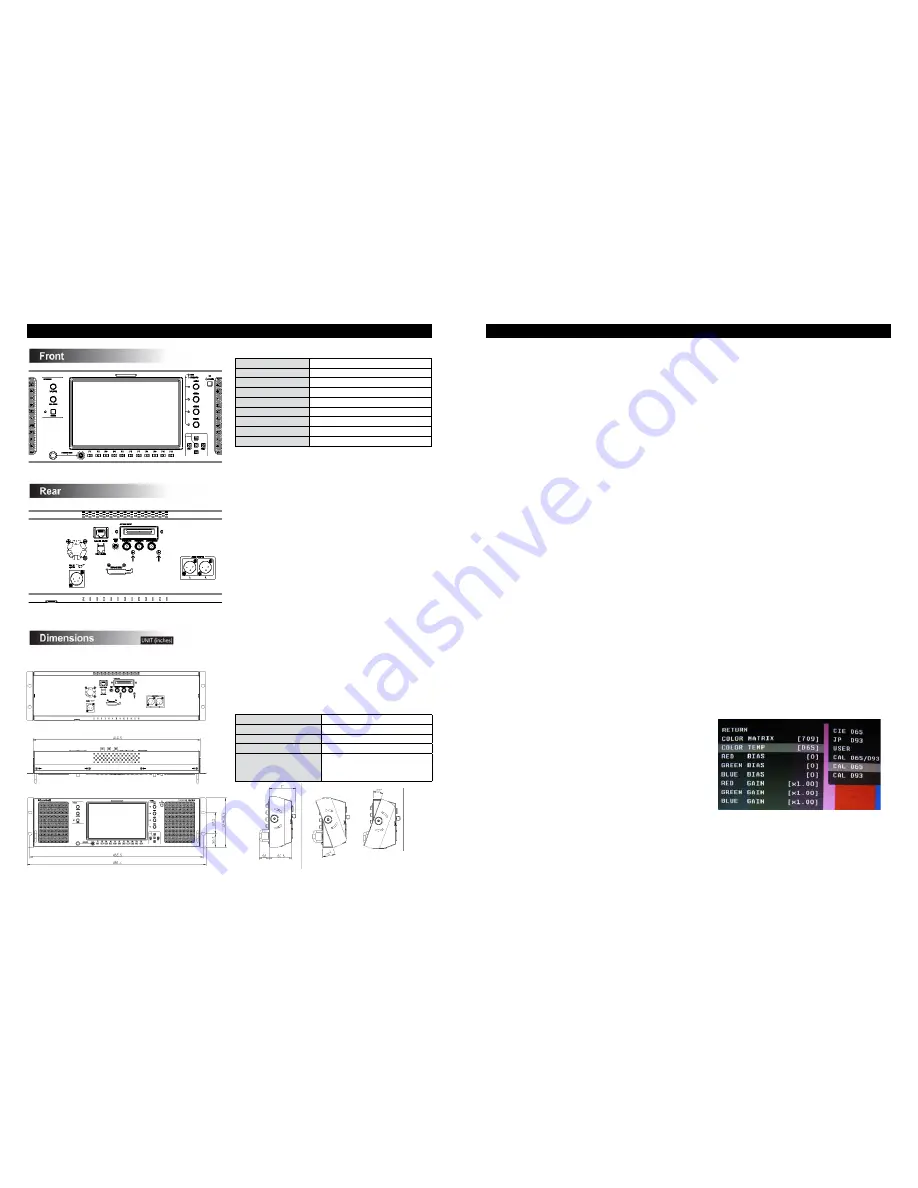
Specifications
Screen Size
7” Diagonal
Display Area (h x v)
6” x 3.6”
Aspect Ratio
16:10 (16:9 / 4:3 Selectable)
Pixels
800 x 480
Color Depth
8-bit (16.7M Colors)
Viewing Angle (h x v)
-55
°
~+65° x -40° ~+50° (CR >10)
Brightness
350 cd/m2
Contrast Ratio
400:1
Pixel Pitch (h x v)
0.1905 x 0.1905 mm
Dimensions (w x h x d)
18.9” x 5.2” x 2.4”
Weight (Monitor Only)
6 lbs including power adapter
Operating Temperature
32° F to 104° F (0° C to 40° C)
Storage Temperature
-4° F to104° F (-20° C to 40° C)
RoHs
Do not dispose. Return to
Manufacturer or Authorized
Recycle Facility.
■
PANEL
■
VIDEO INPUT/OUTPUT
HD/SD-SDI Video Input / Output
■
AUDIO INPUT/OUTPUT
Up to 16 channels of audio de-embedded from the SDI signal
Dual Headphone outputs on Front Panel
3.5mm -10dBu Un-Balanced output on rear panel
Stereo 3-pin XLR Ba4dBu Line Output on rear panel
■
CONNECTORS
Video Input
- 2 x BNC Female (75 Ω)
Video Output (Active Loop-Through)
- 1 x BNC Female (75 Ω)
Parallel Remote
- RJ-45
Optional Input Slot
Audio Output Jacks:
Front 3.5mm Stereo Headphone
Front ¼” Stereo Headphone
Rear
XLR Bal +4 Stereo Line Output
Rear
3.5mm -10 Un-Balanced Line Output
Service Terminal
Power Input
: 4-Pin Male XLR
Pin 1: GND
Pin 2: N/C
Pin 3: N/C
Pin
4:
+12VDC
■
ELECTRICAL
Power Consumption
- 2 Amp (Max) @ 12VDC (24W Max)
Voltage Requirement
- 12VDC (10VDC-18VDC)
■
MECHANICAL
22
23
Maintenance / Color Calibration / Upgrade Procedure
■
Screen Cleaning
Periodically clean the screen surface using ammonia-free cleaning wipes (Marshall Part No. V-HWP-K).
A clean micro-fiber cloth can also be used using only non-abrasive and ammonia-free cleaning agents.
Do not use paper towels. Paper towel fibers are coarse and may scratch the surface of the polycarbonate
faceplate or leave streaks on the surface. Antistatic and fingerprint resistant cleaning agents are recommended.
Do not apply excessive pressure to the screen to avoid damaging the LCD.
■
Faceplate Dusting
Dust the unit with a soft, damp cloth or chamois. Dry or abrasive cloths may cause electrostatic charge on the
surface, attracting dust particles. Neutralize static electricity effects by using the recommended cleaning and
polishing practice.
■
Color Calibration Procedure
*** In order to perform color calibration an optional OR-SM Service Module is required. ***
• Allow both the unit you want to calibrate and the Minolta® CA-210 to warm up for a minimum of 20 minutes.
• Attach the CA-210 color probe to the update dongle.
• With the unit still turned on, insert the update dongle into the service port at the rear of the screen you wish to
calibrate.
• Use the menu navigation joystick or menu buttons of the appropriate screen and go to:
Color Menu Color Temp
• Cal D65/D93 to calibrate both
• Cal D65 to calibrate only D65
• Cal D93 to calibrate only D93
Press enter once to select and again to confirm
• Follow the on-screen instructions
Notes:
1. If there is no color probe attached or you make a mistake and try to calibrate the incorrect screen, you will get an error message and
the screen will default to previous settings.
2. If the calibration process is interrupted while in progress, the current screen settings will be corrupted and the calibration process
will have to be repeated.
■
Upgrading Orchid Firmware
*** In order to install new firmware an optional OR-SM Service Module is required. ***
Procedure:
1. Download the Orchid update software package from the Marshall web site
2. Unzip the included files from the zip folder to a known location on your computer
3. Double-click the Un-Zipped Orchid Update program and firmware package to install on your computer
4. Turn on the Orchid unit to be upgraded
5. Connect the OR-SM module to your computer
6. Insert the OR-SM module into the Service port
7. Run the Orchid Update program
8. Click Update
• The Updater will check for available software
• Compare it to the current version
• Perform the update.
Notes:
•
The update process will take approximately 8 minutes.
•
If the Update program does not automatically detect your Orchid model you will be asked to choose the appropriate model from a
drop down list then click Update again.
•
Clicking on Details allows you to monitor the update process













